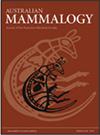Environmental factors influencing the distribution of the Kangaroo Island dunnart (Sminthopsis fuliginosus aitkeni)
IF 1.2
4区 生物学
Q3 ZOOLOGY
引用次数: 0
Abstract
Determining the factors that drive the distributions of threatened species is often critical for informing effective conservation management actions. Species distribution models can be used to distinguish common habitat features shared by limited historical records and identify other areas where a species might persist. In this study, we built a species distribution model for the Endangered and cryptic Kangaroo Island dunnart (Sminthopsis fuliginosus aitkeni). We fitted generalised linear models using incidental records and presence-absence data from surveys between 1969 and 2018. In the models we included the variables rainfall, percentage native vegetation in the surrounding 2 km2, and post-fire vegetation age. The modelling suggested that rainfall and to a lesser extent post-fire vegetation age are good predictors of dunnart occurrence, with dunnart occurrence greatest in areas of high rainfall (>600 mm) and vegetation age classes <30 years post fire. Potentially suitable habitat for the KI dunnart was predicted to be on the central-western side of Kangaroo Island. These results suggest that careful fire management could benefit the dunnart, and that decreased rainfall (as projected by Australian climate models), will be a threat in the long term. Extensive recent fires on western Kangaroo Island suggest that climate-related threats are already being realised.影响袋鼠岛杜纳特分布的环境因素
确定驱动受威胁物种分布的因素通常对于通知有效的保护管理行动至关重要。物种分布模型可以用来区分有限的历史记录所共有的共同栖息地特征,并确定物种可能存在的其他区域。本文建立了濒危和隐蔽的袋鼠岛矮袋鼠(Sminthopsis fuliginosus aitkeni)的物种分布模型。我们使用1969年至2018年期间调查的偶然记录和在场-缺席数据拟合了广义线性模型。在模型中,我们包括了降雨量、周围2 km2的原生植被百分比和火灾后的植被年龄等变量。该模型表明,降雨和较小程度的火灾后植被年龄是沙丘发生的良好预测因子,在高降雨量(60 600 mm)和植被年龄等级<30年的地区,沙丘发生最多。据预测,可能适合KI dunnart的栖息地位于袋鼠岛的中西部。这些结果表明,仔细的火灾管理可能有利于沼泽,而从长远来看,降雨减少(正如澳大利亚气候模型预测的那样)将是一个威胁。袋鼠岛西部最近发生的大规模火灾表明,与气候有关的威胁已经成为现实。
本文章由计算机程序翻译,如有差异,请以英文原文为准。
求助全文
约1分钟内获得全文
求助全文
来源期刊

Australian Mammalogy
ZOOLOGY-
CiteScore
2.50
自引率
8.30%
发文量
26
期刊介绍:
Australian Mammalogy is a major journal for the publication of research in all branches of mammalogy. The journal’s emphasis is on studies relating to Australasian mammals, both native and introduced, and includes marine mammals in the Antarctic region. Subject areas include, but are not limited to: anatomy, behaviour, developmental biology, ecology, evolution, genetics, molecular biology, parasites and diseases of mammals, physiology, reproductive biology, systematics and taxonomy.
Australian Mammalogy is for professional mammalogists, research scientists, resource managers, consulting ecologists, students and amateurs interested in any aspects of the biology and management of mammals.
Australian Mammalogy began publication in 1972 and is published on behalf of the Australian Mammal Society.
 求助内容:
求助内容: 应助结果提醒方式:
应助结果提醒方式:


